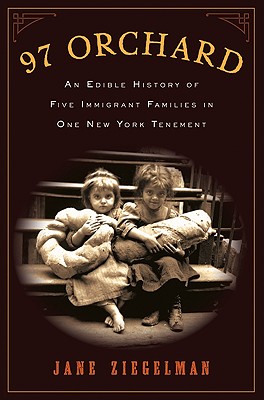 One of my favorites of the season is a bit of a sleeper and an absolute gem: 97 ORCHARD: An Edible History of Five Immigrant Families in One New York Tenement, by Jane Ziegelman. 97 ORCHARD is perfect for foodies and fans of popular history. The title is
One of my favorites of the season is a bit of a sleeper and an absolute gem: 97 ORCHARD: An Edible History of Five Immigrant Families in One New York Tenement, by Jane Ziegelman. 97 ORCHARD is perfect for foodies and fans of popular history. The title isthe address of a tenement built in 1863 on Manhattan's Lower East Side and the stories of the five families bring to life the immigrant experience in America in the late 19th and early 20th Century in a delightful and insightful fashion. Germans, Irish, Eastern European Jews and Italians congregated in this densely populated
neighborhood in New York, and each brought unique culinary traditions to their new country. This was not
easily undertaken in the conditions in which the families lived. The kitchens in the tenements were small windowless rooms with coal or woodburning stoves and little else. Though the city was piping water into the neighborhood when 97 Orchard was built, the builder chose not to bring it to his tenement and water had to be hauled in and up. Communal outhouses were behind the building. Conditions inside were cramped and crowded
so much of the life of the building took place on the stairwells and front stoops.
In spite of the difficult conditions, the immigrants managed to recreate their national cuisines. 97 ORCHARD describes in vivid detail the manner in which the dishes were made. The Glockners arrived from Germany mid 19th Century. Like most Germans they loved their hassenpeffer, wild rabbit ragout. After cutting and seasoning, the rabbits were covered and left for three days before cooking. The hassenpeffer might be accompanied by green dumplings and egg noodles, and the author thoughtfully includes authentic recipes for these and many other dishes throughout the book.
Next we meet the Moore family from Ireland. The potato blight triggered a mass exodus from Ireland, though not a robust culinary tradition since there really wasn't much to work with. Still, we learn much about the Irish experience in New York. Indeed, 97 ORCHARD often reads like a novel in it's lively details about intimate family life, work and culture, along with the cuisine.
The Gompertz family, German Jews, arrived at 97 Orchard in 1870. The Jewish cooks had to
learn how to adopt their Kosher traditions to their new home. Jewish cooks used goose fat as their cooking fat. In Europe, housewives raised the geese, giving them free range until the last month before slaughter when the geese were restricted to the goose house and fattened by force feeding with a sort of dumpling. The recipe and serving suggestions (yes, serving sizes for the geese) is included in this fascinating chapter. In New York the geese lived in tenement poultry farms, indoors, with their owners living in adjacent rooms. This, to say the least, was a smelly nuisance, and the New York Board of Health struggled mightily with the issue for many years.
The Rogarshevsky Family, Lithuanian Jews, landed on Ellis island in 1901 and were among
the 10% or so who were temporarily detained. The reason given was that they had no money, though they were bailed out in a few days by relatives. Women traveling alone were held on Ellis Island until a male relative came to fetch them. Detention could last for weeks or months. A great deal of this chapter details the rules and culture of Ellis Island. Detainees were housed in large dormitories and the island was almost a city unto itself. A bleak place to bide one's time while waiting to reach the goal of a new life on American soil.
Italian immigrants in the early 20th Century faced intense discrimination and hostility. Quotas severely restricted Italian immigration and many entered the country as stowaways or with doctored papers. Such was the case with Adolfo and Rosario Baldazzi, who arrived in the early 1920's and called 97 Orchard home through the Great Depression. For any number of reasons the cuisine of the Italian immigrants was particularly suspect, with great effort made to reform their eating habits. The new way of American life tested Italian customs, but the evening meal, the "communion of the family", prevailed, with their deep reverence for traditional foods and large family gatherings remaining intact.
97 Orchard, the building, is now part of the New York City Tenement Museum. Visitors can
tour the tenement and experience the history that Jane Ziegelman brings to life in her wonderful book. I would love to visit the museum but even now feel like a bit of a voyeur after learning intimate details of the lives and meals of the residents of this intersection of the American immigrant experience. Many of the dishes in 97 ORCHARD, once considered strange, are now integral to American cuisine and this cultural acceptance and absorption continues today. Witness the popularity of falafel, samosas, posole and sushi. Bon appetit and happy reading!
(originally published at gabbygourmet.com)
No comments:
Post a Comment